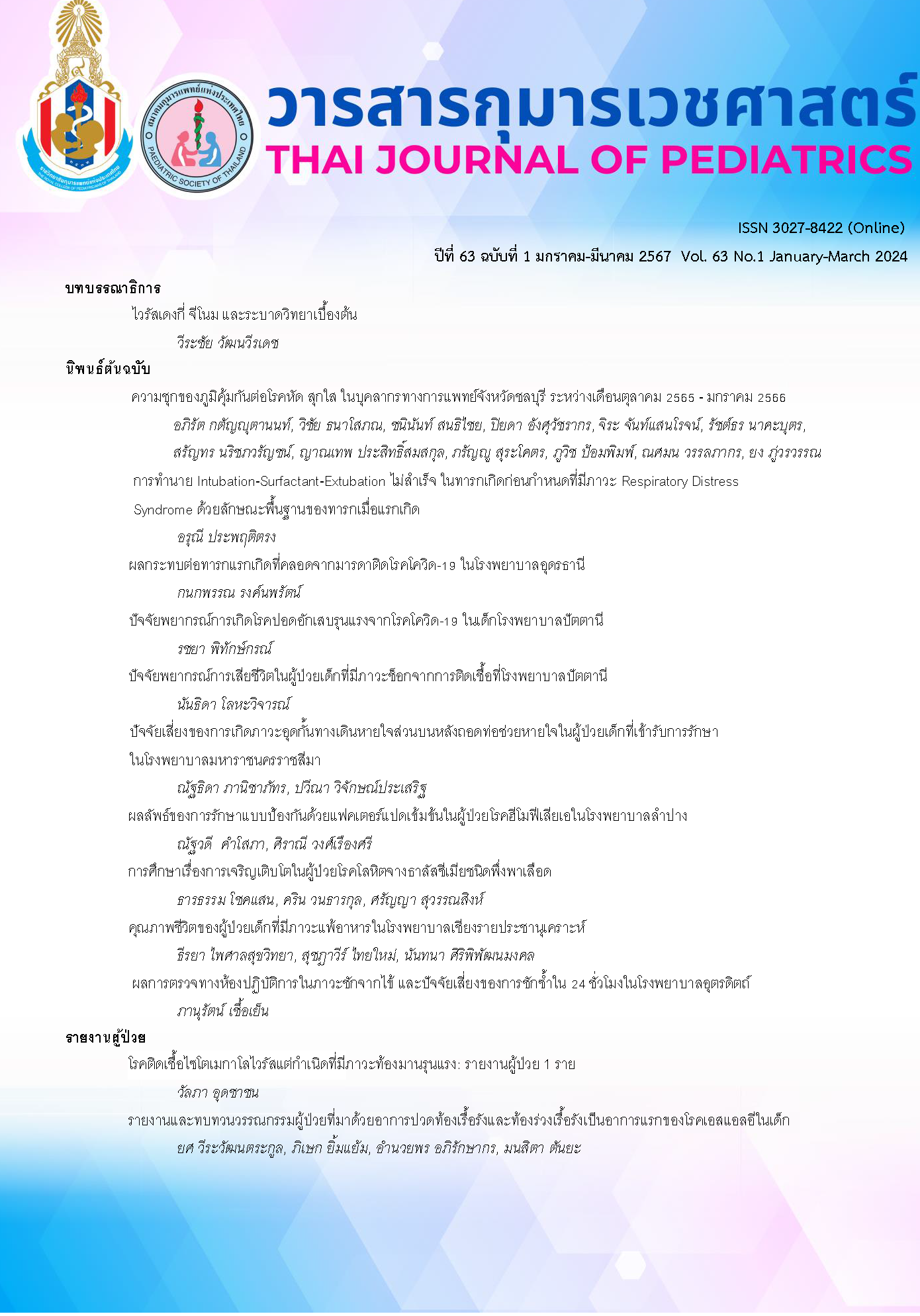ปัจจัยพยากรณ์การเสียชีวิตในผู้ป่วยเด็กที่มีภาวะช็อกจากการติดเชื้อที่โรงพยาบาลปัตตานี
คำสำคัญ:
ภาวะติดเชื้อ , ภาวะช็อกจากการติดเชื้อ , เด็กเสียชีวิต , ปัจจัยพยากรณ์ , ภาวะเลือดเป็นกรดบทคัดย่อ
ความเป็นมา: ภาวะช็อกจากการติดเชื้อเป็นสาเหตุการตายในเด็กทั่วโลก แม้จะมีแนวทางการวินิจฉัยและการรักษา แต่อัตราการเสียชีวิตจากภาวะดังกล่าวยังสูง
วัตถุประสงค์: เพื่อศึกษาปัจจัยพยากรณ์การเสียชีวิตในผู้ป่วยเด็กที่มีภาวะช็อกจากการติดเชื้อ
วิธีการศึกษา: เป็นการศึกษาเชิง prognostic factor research รูปแบบ retrospective observational cohort design ที่หอผู้ป่วยวิกฤตเด็ก โรงพยาบาลปัตตานี ศึกษาในผู้ป่วยเด็กที่มีภาวะช็อกจากการติดเชื้ออายุมากกว่า 1 เดือน ถึง 15 ปี ตั้งแต่ 1 มกราคม พ.ศ. 2560 ถึง 31 ธันวาคม พ.ศ. 2564 เปรียบเทียบกลุ่มที่เสียชีวิตและรอดชีวิตด้วย t-test, Fisher exact probability test และวิเคราะห์ลักษณะพยากรณ์ ด้วย risk ratio จาก multivariable logistic regression analysis
ผลการศึกษา: ผู้ป่วยเด็กที่มีภาวะช็อกจากการติดเชื้อทั้งหมด 84 ราย เสียชีวิตระหว่างนอนโรงพยาบาล 51 ราย เมื่อนำลักษณะที่เป็นปัจจัยพยากรณ์การเสียชีวิตในผู้ป่วยเด็ก 10 ปัจจัยจาก univariable analysis มาวิเคราะห์ร่วมกัน ลักษณะที่ยังคงมีนัยสำคัญทางสถิติ ได้แก่ 1. การดำเนินโรคของการติดเชื้อไปเป็นการติดเชื้อและมีภาวะช็อกภายใน 7 วัน (risk ratio [RR] 5.5995% CI 2.07-15.09) 2. มีภาวะเลือดเป็นกรด (RR 1.65, 95% CI 1.13-2.42)
สรุป: ผู้ป่วยเด็กที่มีภาวะติดเชื้อต้องเฝ้าระวังการดำเนินโรค โดยเฉพาะอย่างยิ่งใน 7 วันแรกและในเด็กที่มีภาวะเลือดเป็นกรด
Downloads
เอกสารอ้างอิง
Weiss SL, Peters MJ, Alhazzani W, Agus MSD, Flori HR, Inwald DP, et al. Surviving sepsis campaign international guidelines for the management of septic shock and sepsis-associated organ dysfunction in children. Pediatr Crit Care Med. 2020;21(2):e52-e106.
Limprayoon K, Phumeetham S, Saito N. Effect of the ‘SURVIVING SEPSIS CAMPAIGN 2012’ on mortality in the pediatric department of Siriraj Hospital. Southeast Asian J Trop Med Public Health. 2017;48:79-87.
Rusmawatiningtyas D, Rahmawati A, Makrufardi F, Mardhiah N, Murni IK, Uiterwaal CSPM, et al. Factors associated with mortality of pediatric sepsis patients at the pediatric intensive care unit in a low-resource setting. BMC Pediatr. 2021;21:471.
Phumeetham S, Preeprem N. Factors significantly associated with death among pediatric septic shock patients in a resource-limited setting. Southeast Asian J Trop Med Public Health. 2021;52:663-75.
Shah S, Deshmukh CT, Tullu MS. The predictors of outcome and progression of pediatric sepsis and septic shock: A prospective observational study from western India. J Postgrad Med. 2020;66:67-72.
de Souza DC, Machado FR. Epidemiology of pediatric septic shock. J Pediatr Intensive Care 2019;8:3-10.
Uppala R, Wongrat C. Mortality and predictive factors in pediatric severe sepsis and septic shock after implementation of Surviving Sepsis Campaign Guideline in Srinagarind Hospital. Srinagarind Med J 2020;35:404-9.
Yuniar I, Karyanti MR, Kurniati N, Handayani D. The clinical and biomarker approach to predict sepsis mortality in pediatric patients. Paediatr Indones. 2023;63:37-44.
Kaur G, Vinayak N, Mittal K, Kaushik JS, Aamir M. Clinical outcome and predictors of mortality in children with sepsis, severe sepsis, and septic shock from Rohtak, Haryana: A prospective observational study. Indian J Crit Care Med. 2014;18:437-41.
Branco RG, Garcia PCR, Piva JP, Casartelli CH, Seibel V, Tasker RC. Glucose level and risk of mortality in pediatric septic shock. Pediatr Crit Care Med. 2005;6:470-2.
Paudel R, Bissell B, Dogra P, Morris PE, Chaaban S. Serum bicarbonate: Reconsidering the importance of a neglected biomarker in predicting clinical outcomes in sepsis. Cureus. 2022;14(4):e24012.
Maitland K, Kiguli S, Opoka RO, Engoru C, Olupot-Olupot P, Akech SO, et al. Mortality after fluid bolus in African children with severe infection. N Engl J Med. 2011;364:2483-95.
Goyal P, Chandra D, Goel D, Kumar D, Kumari A, Prasad P. Predictors of outcome in pediatric septic shock: Experience from a tertiary care teaching hospital. Pediatr Rev Int J Pediatr Res. 2019;6:489-94.
Spitalnic S, Sidman RD, Monti J. Serum bicarbonate and anion gap cannot reliably predict elevated serum lactate levels. Ann Emerg Med. 2004 1;44:S54.
ดาวน์โหลด
เผยแพร่แล้ว
รูปแบบการอ้างอิง
ฉบับ
ประเภทบทความ
สัญญาอนุญาต
ลิขสิทธิ์ (c) 2024 ราชวิทยาลัยกุมารแพทย์แห่งประเทศไทย และ สมาคมกุมารแพทย์แห่งประเทศไทย

อนุญาตภายใต้เงื่อนไข Creative Commons Attribution-NonCommercial-NoDerivatives 4.0 International License.



